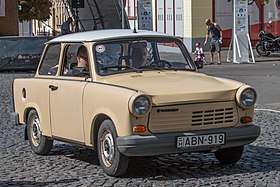Trabant 1.1
The Trabant 1.1 (German: [tʁaˈbant aɪns pʊŋkt aɪns]) is the fourth and final series production model of the East German Trabant series, made by VEB Sachsenring Automobilwerke Zwickau. Unlike its predecessors, which have a two-stroke engine, the Trabant 1.1 has a four-stroke Otto engine. In total, 39,474[1] units of the Trabant 1.1 were made from May 1990 to 30 April 1991,[2] which makes it the rarest Trabant model.
| Trabant 1.1 | |
|---|---|
 Trabant 1.1 Saloon | |
| Overview | |
| Manufacturer | VEB Sachsenring |
| Also called | Trabbi - Tribco |
| Production | 1990–1991 |
| Assembly | Zwickau, Germany |
| Body and chassis | |
| Class | B-segment |
| Body style | 2-door saloon (Limousine) 2-door estate (Universal) Doorless ATV (Tramp) |
| Layout | FF |
| Platform | Trabant 1.1 |
| Related | VW Polo 86C |
| Powertrain | |
| Engine | Barkas B820 (Otto, 1042 cm³, 30 kW) |
| Transmission | 4-speed manual |
| Dimensions | |
| Wheelbase | 2,020 mm (6 ft 8 in) |
| Length | 3,410 mm (11 ft 2 in) |
| Width | 1,510 mm (4 ft 11 in) |
| Height | 1,440 mm (4 ft 9 in) |
| Kerb weight | 700 kg (1,543 lb) |
| Chronology | |
| Predecessor | Trabant 601 |
| Successor | None |
Most Trabant 1.1 were exported to Poland and Hungary. In Germany, it did not sell very well; in 1990, the 1.1 saloon was offered at a price of DM 10,887,[3] which, at the time, was considered overpriced.
Technical description
The Trabant 1.1 is a small compact car that uses the front-engine, front-wheel-drive layout. It was made in limousine, universal, and tramp body styles. The limousine is a two-door saloon, the universal a three-door estate, and the tramp is a doorless ATV off-road-like vehicle with a canvas roof.[4]
Like its predecessors, the 1.1 has a self-supporting body with a steel frame, and body parts made of duroplast. In front, the Trabant has independent suspension with MacPherson struts and triangular control arms; in rear, it has independent suspension with coil springs mated with hydraulic shock absorbers and diagonal control arms. The braking system is a dual-circuit hydraulic system with disc brakes on the front, and drums on the rear wheels. A rack-and-pinion system is used for steering. The wheelsize is 13 in (330 mm).[5]
The Trabant is powered by a carburetted, water-cooled, Barkas B820 four-cylinder, OHC, Otto engine (a version of the VW EA 111 engine produced under licence). This engine displaces 1.1 litres and is rated 30 kW; it produces a maximum torque of 72.6 N·m. The torque is transmitted from the engine to the front wheels with a dry single-disc clutch and a manual four-speed gearbox. Unlike the Trabant 601, the 1.1 does not have a column mounted gear shifter, instead, it uses a floormounted gearshift lever on the right-hand side of the driver's seat.[5]
The fuel consumption is rated 8 l/100 km, the top speed 125 km/h, and the acceleration from 0–100 km/h is said to be 22 s.[5]
Gallery
 Trabant 1.1 engine
Trabant 1.1 engine.jpg) Trabant 1.1 Tramp
Trabant 1.1 Tramp Trabant 1.1 Universal
Trabant 1.1 Universal- Trabant 1.1 Universal (rear view)
.jpg) Trabant 1.1 Limousine (rear view)
Trabant 1.1 Limousine (rear view)
References
- A. J. Jacobs: Automotive FDI in Emerging Europe: Shifting Locales in the Motor Vehicle Industry, Springer 2017, ISBN 9781137407863, p. 112
- Werner Oswald (ed.): Kraftfahrzeuge der DDR. 2nd edition. Motorbuch-Verlag, Stuttgart 2000, ISBN 3-613-01913-2, p. 60
- Jan Tuček: Auta východního bloku, Grada Publishing a.s. 2009, ISBN 9788024725857, p. 202–203
- Werner Oswald (ed.): Kraftfahrzeuge der DDR. 2nd edition. Motorbuch-Verlag, Stuttgart 2000, ISBN 3-613-01913-2, p. 62
- Werner Oswald (ed.): Kraftfahrzeuge der DDR. 2nd edition. Motorbuch-Verlag, Stuttgart 2000, ISBN 3-613-01913-2, p. 64
External links
| Wikimedia Commons has media related to Trabant 1.1. |